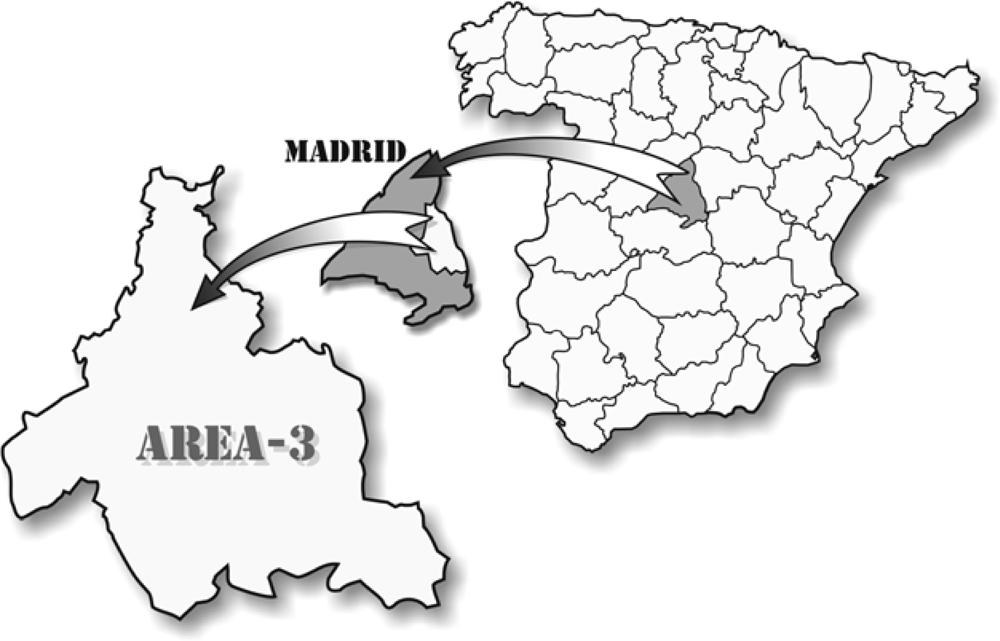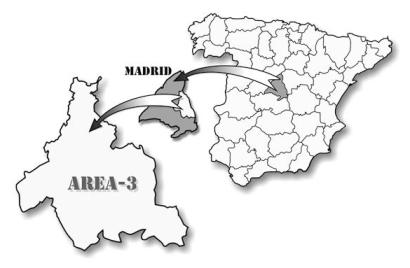Epidemiological Study of Rickettsial Infections in Patients with Hypertransaminemia in Madrid (Spain)
Abstract
:1. Introduction
2. Patients and Methods
3. Molecular Methods
4. Results
4. Discussion
References
- Blanco, JR; Oteo, JA. Rickettsiosis in Europe. Ann. N. Y. Acad. Sci 2006, 1078, 26–33. [Google Scholar]
- Sousa, R; Luz, T; Parreira, P; Santos-Silva, M; Bacellar, F. Boutonneuse fever and climate variability. Ann N Y Acad Sci 2006, 1078, 162–169. [Google Scholar]
- Walker, DH; Staiti, A; Mansueto, S; Tringali, G. Frequent occurrence of hepatic lesions in Boutonneuse Fever. Acta Tropica 1986, 43, 175–181. [Google Scholar]
- Silpapojakul, K; Mitarnun, W; Ovartlarnporn, B; Chamroonkul, N; Khow-Ean, U. Liver involvement in murine typhus. Q. J. Med 1996, 89, 623–629. [Google Scholar]
- Letaïef, A; Kaabia, N; Chakroun, M; Khalifa, M; Bouzouaia, N; Jemni, L. Clinical and laboratory features of murine typhus in central Tunisia: a report of seven cases. Int. J. Infect. Dis 2005, 9, 331–334. [Google Scholar]
- Márquez, FJ; Muniain, MA; Pérez, JM; Pachón, J. Presence of Rickettsia felis in the cat flea from southwestern Europe. Emerg Infect Dis 2002, 8, 89–91. [Google Scholar]
- Ibarra, V; Oteo, JA; Portillo, A; Santibañez, S; Blanco, JR; Metola, L; Riros, JM; Pérez-Martínez, L; Sanz, M. Rickettsia slovaca infection: DEBONEL/TIBOLA. Ann. N. Y. Acad. Sci 2006, 1078, 206–214. [Google Scholar]
- Phillip, RN; Casper, EA; Ormsbee, RA; Peacock, MG; Burgdorfer, W. Microimmunofluorescence test for the serological study of Rocky Mountain Spotted Fever and Typhus. J. Clin. Microbiol 1976, 3, 51–61. [Google Scholar]
- Regnery, RL; Spruill, CL; Plikaytis, BD. Genotypic identification of Rickettsiae and estimation of intraspecies sequence divergence for portions of two rickettsial genes. J. Bacteriol 1991, 173, 1576–1589. [Google Scholar]
- Sousa, R; Ismail, N; Dória-Nóbrega, S; Costa, P; Abreu, T; Franca, A; Amaro, M; Proenca, P; Brito, P; Pocas, J; Ramos, T; Cristina, G; Pombo, G; Vitorino, L; Torgal, J; Bacellar, F; Walker, D. The presence of eschars, but not greater severity, in Portuguese patients infected with Israeli Spotted Fever. Ann. N. Y. Acad. Sci 2005, 1063, 197–202. [Google Scholar]
- Renvoisé, A; Raoult, D. L’actualité des rickttsioses. Med Mal Infect 2009, 39, 71–81. [Google Scholar]
- García San Miguel, J; Soriano, E; Bruguera, M; Martínez-Vea, A; Vivancos, J; Urbano-Márquez, A. La afección hepática en la Fiebre Botonosa. Med Clin (Barc) 1979, 72, 175–178. [Google Scholar]
- Beorchia, S; Rouchier, D; Woehrle, R; Monin, F; Évreux, M; Brette, R. Anomalies hépatiques au cours de la fiévre boutonneuse méditerranéenne. Ann. Gastroenterol. Hepatol 1980, 22, 87–90. [Google Scholar]
- Guardia, J; Vilaseca, J; Moragas, A; Martínez-Vázquez, JM; Bombi, AJ; Calders, J; Bacardi, R. Hepatitis in Exanthemetous Mediterranean Fever (1981). Hepato-Gastroenterol 1981, 28, 81–83. [Google Scholar]
- Abril, V; Ortega, E; Ruiz, C; Soler, JJ; Fraile, T; Monzo, V; Herrera, A. Afección hepática en la Fiebre Q y en la Fiebre Botonosa Mediterránea. Estudio comparativo. Rev. Esp. Enferm. Dig 1994, 86, 891–893. [Google Scholar]
- Germanakis, A; Psaroulaki, A; Gikas, A; Tselentis, Y. Mediterranean Spotted Fever in Crete, Greece. Ann. N. Y. Acad. Sci 2006, 1078, 263–269. [Google Scholar]
- Dumler, JS; Taylor, JP; Walker, DH. Clinical and laboratory features of murine typhus in south Texas, 1980 through 1987. JAMA 1991, 266, 1365–1370. [Google Scholar]
- Sousa, R; Barata, C; Vitorino, L; Santos-Silva, M; Carrapato, C; Torgal, J; Walker, D; Bacellar, F. Rickettsia sibirica isolation from a patient and detection in ticks, Portugal. Emerg. Infect. Dis 2006, 12, 1103–1108. [Google Scholar]
- Degos, F. Granulomes hépatiques d’origine infectieuse. Rev. Prat 2001, 51, 2075–2080. [Google Scholar]
- Madison, G; Kim-Schuger, L; Braverman, S; Nicholson, WL; Wormser, GP. Hepatitis in association with rickettsial pox. Vector Borne Zoonotic Dis 2008, 8, 111–115. [Google Scholar]
- Oteo, JA; Portillo, A; Santibáñez, S; Blanco, JR; Pérez-Martínez, L; Ibarra, V. Cluster of cases of human Rickettsia felis infection from Southern Europe (Spain) diagnosed by PCR. J. Clin. Microbiol 2006, 44, 2669–2671. [Google Scholar]
- Segura, F; Font, B; Espejo, E; Bella, F. New trends in Mediterranean Spotted Fever. Eur. J. Epidemiol 1989, 5, 438–443. [Google Scholar]
- Miguélez, M; Laynez, P; Linares, M; Hayek, M; Abella, L; Marañez, I. Tifus murino en Tenerife. Estudio clínico-epidemiológico y características clínicas diferenciales con la Fiebre Q. Med. Clin. (Barc) 2003, 121, 613–615. [Google Scholar]
- Parra, J; Peña, A; Tomas, C; Parejo, MI; Vinuesa, D; Muñoz, L; Martínez, MA; García, F; Hernández, J. Clinical spectrum of fever of intermediate duration in the south of Spain. Eur. J. Clin. Microbiol. Infec. Dis 2008, 27, 993–995. [Google Scholar]
- Santibañez, S; Ibarra, V; Portillo, A; Blanco, JR; Martínez de Artola, V; Guerrero, A; Oteo, JA. Evaluation of IgG antibody response against Rickettsia conorii and Rickettsia slovaca in patients with DEBONEL/TIBOLA. Ann N Y Acad Sci 2006, 1078, 570–572. [Google Scholar]
- Segura, F; Diestre, G; Ortuño, A; Sanfeliu, I; Font, B; Muñoz, T; Mateu, E; Casal, J. Prevalence of antibodies to spotted fever group rickettsiae in human beings and dogs from an endemic area of Mediterranean spotted fever in Catalonia, Spain. Eur. J. Epidemiol 1998, 14, 395–398. [Google Scholar]
- Nogueras, MM; Cardeñosa, N; Sanfeliu, I; Muñoz, T; Font, B; Segura, F. Evidence of infection in humans with Rickettsia typhi and Rickettsia felis in Catalonia in the Northeast of Spain. Ann. N. Y. Acad. Sci 2006, 1078, 159–161. [Google Scholar]
- Bernabeu-Wittel, M; del Toro, MD; Nogueras, MM; Muniain, MA; Cardeñosa, N; Márquez, FJ; Segura, F; Pachón, J. Seroepidemiological study of Rickettsia felis, Rickettsia typhi, and Rickettsia conorii infection among the population of southern Spain. Eur. J. Clin. Microbiol. Infect. Dis 2006, 25, 375–381. [Google Scholar]
- Alexiou-Daniel, S; Manika, K; Arvanitidou, M; Antoniadis, A. Prevalence of Rickettsia conorii and Rickettsia typhi infections in the population of northern Greece. Am J Trop Med Hyg 2002, 66, 76–79. [Google Scholar]
- Letaïef, A. Epidemiology of rickettsioses in North Africa. Ann. N. Y. Acad. Sci 2006, 1078, 34–41. [Google Scholar]

| Patients n (%) | Mean | Range | |
|---|---|---|---|
| ALT >35 U/L | 112 (78.3) | 97.4 | 36–2150 |
| AST >38 U/L | 57 (39.8) | 91.3 | 39–1480 |
| Clinical findings | R. conorii N (%) | R. typhi N (%) |
|---|---|---|
| Lymphocytosis | 4 (25%) | 5 (50%) |
| Lymphopenia | 3 (18.7%) | 2 (20%) |
| Thrombocytopenia | 2 (12.5%) | - |
| Hyperbilirubinemia | 4 (25%) | 2 (20%) |
| Elevated alkaline phosphatase | 4 (25%) | 4 (40%) |
| Elevated GGT | 4 (25%) | 2 (20%) |
| Elevated lactate dehydrogenase | 3 (18.7%) | 2 (20%) |
| Groups | Titer 1/128 | Titer 1/256 | Titer 1/512 | Titer 1/1024 | Titer 1/2048 |
|---|---|---|---|---|---|
| Patient with Ab-R. conorii | 6 (4.2%) | 5 (3.5%) | 5 (3.5%) | - | - |
| Patient with Ab-R. typhi | 3 (2.1%) | 4 (2.8%) | 2 (1.2%) | - | 1 (0.7%) |
| Control population with Ab-R. conorii | 3 (2.1%) | - | 4 (2.8%) | - | - |
| Control population with Ab-R. typhi | 2 (1.2%) | 1 (0.7%) | 1 (0.7%) | - | - |
© 2009 by the authors; licensee Molecular Diversity Preservation International, Basel, Switzerland. This article is an open-access article distributed under the terms and conditions of the Creative Commons Attribution license (http://creativecommons.org/licenses/by/3.0/).
Share and Cite
Lledó, L.; González, R.; Gegúndez, M.I.; Beltrán, M.; Saz, J.V. Epidemiological Study of Rickettsial Infections in Patients with Hypertransaminemia in Madrid (Spain). Int. J. Environ. Res. Public Health 2009, 6, 2526-2533. https://doi.org/10.3390/ijerph6102526
Lledó L, González R, Gegúndez MI, Beltrán M, Saz JV. Epidemiological Study of Rickettsial Infections in Patients with Hypertransaminemia in Madrid (Spain). International Journal of Environmental Research and Public Health. 2009; 6(10):2526-2533. https://doi.org/10.3390/ijerph6102526
Chicago/Turabian StyleLledó, Lourdes, Rosario González, María Isabel Gegúndez, María Beltrán, and José Vicente Saz. 2009. "Epidemiological Study of Rickettsial Infections in Patients with Hypertransaminemia in Madrid (Spain)" International Journal of Environmental Research and Public Health 6, no. 10: 2526-2533. https://doi.org/10.3390/ijerph6102526





